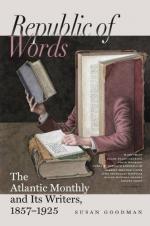cannot treat them, according to his usual method in
such cases, as fabrications of Spanish priests and
lying chroniclers. How, then, does he account
for them? He unfolds a theory on the subject,
which he has stolen from the “monkish chroniclers”
whom he treats with so much contempt, and which has
long ago been exploded and set aside. He tells
us, that these relics have no connection with the
history of the American Aborigines,—that
they have a different origin and a far greater antiquity,—that
they are proofs, not to be gainsaid, of the discovery
of this continent, at a very early date, by Phoenician
adventurers, and of the establishment, in the regions
where they are found, of Phoenician colonies.
These ruins, he tells us, were Phoenician temples,
these statues are the representations of Phoenician
gods. In the comparison of facts by which he endeavors
to support this theory, we have been surprised to
find him admitting the testimony of other explorers.
But they are, it seems, reluctant witnesses.
Their inferences from the facts which they have themselves
collected are directly opposite to his. “Proving
our case,” he says, “by such testimony,
we have admitted their statement of fact, only rejecting
their conclusions.” Their proper business,
it would appear, was to amass the materials which
our author alone was competent to use. He encountered,
indeed, a solitary difficulty; but this, in the most
astonishing manner, has been removed. “Thus
far,” he writes, “had we carried the argument,
but had here been compelled to stop, for want of further
evidence; and the very stereotype plate that at first
occupied this page, expressed our regrets that we
were not able more completely to identify the Palenque
statue as Hercules. At our publishers’,
however, the eyes of that distinguished Orientalist,
the Rev. Mr. Osborn, chanced to fall upon a proof
of the American goddess in the fourth note to this
chapter, which he at once recognized as Astarte, represented
according to an antique pattern. Her head-dress,
he insisted, was in the ancient form of the mural
crown, without the crescent, the prototype of that
worn by Diana of the Ephesians, and so too, he insisted,
was her necklace of ‘two rows.’”
Thus the chain of evidence was complete, and, for
once, Mr. Wilson derived assistance from eyes not
placed in his own head.
But, whatever distinguished Orientalists may say, undistinguished Occidentalists may be pardoned for inquiring when it was that this stream of Phoenician emigration flowed to the American shores, in what manner such an enormous body of colonists as the hypothesis necessarily supposes were conveyed hither, and what has become of their descendants. With an uncommon indulgence to our weakness of faith, Mr. Wilson condescends to meet these obvious questions. The time he cannot exactly fix; but it was “thousands of years ago,”—“before the time of Moses.” To the query in regard to the means of conveyance, he answers, that at that remote period sailing ships




